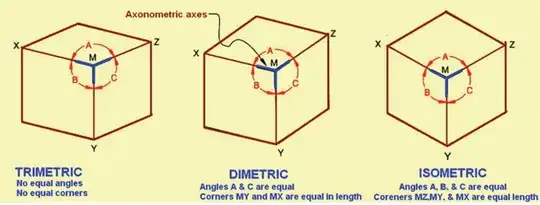I am trying to learn the "rules" of the different types of orthographic projections.
For example:
The above adequately/simply explains the rules of trimetric, dimetric and isometric axonometric projections.
Unfortunately, I have not been able to find a nice info graphic that explains the rules of the different types of oblique projections.
The following is my best educated guess:
Cavalier Left rules:
• Two equal axes & angles
• Angles A & B are equal
• Corners MY and MZ are equal in lengthCavalier Right Rules:
• Two equal axes & angles
• Angles A & C are equal
• Corners MX and MY are equal in lengthMilitary Rules:
• Two equal axes & angles
• Angles B & C are equal
• Corners MX & MZ are equal in length
Questions:
- Are my above guesses correct?
- If not, what are the rules to cavalier and military oblique projections?
I would love some help!

